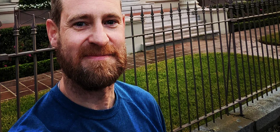
Wayne G has lived a life that many gay men would envy. The British-born, internationally acclaimed circuit party DJ, has spent much of the past 25 years partying hard and traveling the world. He’s enjoyed music success in his own right, as well as a producer and remixer for Cher, Madonna, and Lady Gaga.
The 46-year-old has performed at the like of Sydney Mardi Gras and Southern Decadence in New Orleans and is a resident DJ on Atlantis Cruises.
However, that doesn’t mean his life has been plain sailing. Followers of his social media will know he’s spoken openly about mental health issues, and the last year, in particular, has been tough. The closure of clubs has seen him with almost zero bookings over the last 12 months.
A recent Facebook posting revealed he’d had another battle on his hands: Skin cancer.
How about we take this to the next level?
Our newsletter is like a refreshing cocktail (or mocktail) of LGBTQ+ entertainment and pop culture, served up with a side of eye-candy.
“I have shared my mental health issues, my depressions, and my anxiety and therefore I am now, under guidance, sharing my latest journey. I have skin cancer,” he said.

“Again. In the grander scheme of things, it’s not that serious. It’s caught early. It’s hopefully treatable with minimal risks.
“The reason for this point is, I know a lot of us gays tend to run into the sunshine or the nearest beach and throw olive oil on ourselves or a little more… I have had BCC and SCC for some years now, from my times in Australia, running to the beach and lounging there for hours, when in fact, I am ginger, half Irish and translucent white. Not good.”
He said he wanted to encourage people to “make a conversation about this. Let’s discuss that it’s not healthy and please, at the first sign that you get something on your skin that is abnormal, get to the blooming doctor. I didn’t. Again.”
Related: Gay men’s skin cancer risk may be more complicated than tanning beds
He went on to talk about the treatment he’s undergoing.
“I’m currently nursing a week+ worth of Moh’s surgery that is removing those legions, layer by layer. It’s a great way to make sure it doesn’t come back or you have minimal scars. Check in with your doctor. Regular. Look at your body and notice any weird spots. Even those anal warts.
“Take the steps you need to. Talk about it. With me. With friends. With a doctor. Anyone. Get the help that is there. Please.”
Wayne has been based in his home city of London during the pandemic. He told Queerty more about his experience with skin cancer. He says he was first diagnosed 11 years ago, in his mid-30s.
“The doctor at the time said to me, that I should expect more, continually over the years. This is the third time since then. This one is the worst yet, unfortunately.”
Wayne has had BCC and SCC. These stand for Basal Cell Carcinoma, which accounts for around 75 in every 100 skin cancers, and Squamous Cell Carcinoma, which makes up another 20 of every skin cancer diagnoses. The most serious and aggressive form of skin cancer is melanoma, whereas BCC and SCC are non-melanoma cancers.
BCC and SCC affect cells in the upper layer of your skin, while melanoma affects cells deeper in your epidermis and are more likely to spread to other parts of your body. However, you should seek treatment for all types of skin cancer.
“I noticed some tiny red spots,” says Wayne, recalling the early signs. “I just thought they were general little spots like we all get, but they started to go slightly flakey and I couldn’t pick them off. Then they would reappear.
“They were tiny at first, so I really didn’t think too much of it. Then I asked a doctor friend in Sydney, Australia, about them on my chest thinking it was a rash of sorts and he told me I needed to get them checked out immediately.”
“The doctor has said it’s very likely that I exposed myself too much in Australia over the years. The sun there is harsh, with no ozone layer back in the ’90s.
“I was so delighted to be traveling there for gigs, and then I started staying 2-3 months over their summer.
“I would run to the beaches with friends and slap olive oil on my pasty, half-Irish, ginger skin… I would look like a flamingo for days but would eventually turn brown, which of course, as a young gay man, delighted me. I thought it was more attractive to others and myself.
“The campaigns for skin cancer and staying out of the sun didn’t really kick in until early 00’s really. By then, the damage was already done for me.
“Nowadays, if I have a beach day in Oz, my gorgeous friends have all bought tents for me or umbrellas and I am made to sit under them, slathering myself every hour with sun factor 50. I’m not allowed in direct sunlight with any of them anymore,” he laughs.
Related: What is bigorexia and do you suffer from it?
He knows that he will probably continue to need treatment.
“With the BCC and SCC, this will be an ongoing thing, for years to come. Once you have had that over-exposure, the damage is done. There is no going back.
“Melanoma can be a different thing but, of course, is way more dangerous. I have had two malignant ones removed already. It’s a painful process, and involves chemo or radio, or both.”

What advice would he give to gay men who love to sunbathe for hours or are fond of tanning beds?
“Look, we are adults and it’s lovely being on a beach on holiday with friends, tanning for hours each day over a week or two, but you really have to think about your own skin, and your background. If you do burn easily then stay out of the sun. Period.
“Slap sunscreen on every hour or two. Follow the guidelines that are out there: Don’t sit in the sun between 12-3 pm, the hottest times.
“Look at your skin and body and look for spots that you haven’t seen before or any changes in your freckles or moles. Be aware.
“I don’t think anyone is really ever gonna stop going to the beach but try to protect yourself the best you can. Limit the times you spend there. Re-apply sun protection, especially after coming out of a swim.
“Wear a hat if you can. I now don’t leave the house on any day without suncream on my face or exposed areas. Even in grey, cloudy London.
“Some sunscreens can cause spots but I have found an amazing brand from NZ called Savvytouch. They have an incredible Mango butter SPF 30. It’s been my lifesaver.”
Cancerous lump on the skin will often be red and firm or may look like ulcers. Cancerous patches are more likely to be flat and scaly.
However, if you notice any unusual lumps, ulcers, lesions or skin discoloration that do not heal after four weeks, seek medical advice. The same goes for any moles or freckles that grow, change shape or bleed. Your physician will refer you to a dermatologist or other specialist if you need further investigating.
And don’t forget your sunscreen!




















Chrisk
Olive oil, looking like a flamingo…oh lord. I can’t say i was much better back in my day of tanning though. I was even using cancer bed aka tanning beds.
Yeah, the whole skin cancer message didn’t really take off until the 2000’s. Of course most gay men didn’t really care anyways. Die young. Leave a good looking corpse I guess.
Personally I don’t like looking pasty white. Nor do I want some deep dark tan. I do get a little sun here and there though. However, it’s always with a 30 sunscreen and no more then 2 hours at any given time. I also use a self tanner.
barkomatic
When I was 19 I wanted so bad to be tan when I was younger I laid out in the sun for two hours without sunscreen and ended up with 2nd degree burns. I was a fool and I’ve never tried to get a tan since.
Mr. Stadnick
Good to see this site write and article with some message that maybe someone will heed and not go what this guy is going through. No gossip on cut and paste twitter posts, real writing with actual content.
ediowa
Redheads are my weakness and I married one and have watched him endure all the procedures and recoveries. I never post to anything, but here’s the exception cause I love the redheads. After multiple procedures the dermatologist recommended checking with an oncologist about a new drug (2015) that kills the basel cell actinic keratosis from inside. There were over 20 of these on my man’s back and would have been 20 skin surgeries and risks of infection.. The drug called Erivedge. It’s an oral pill taken daily, and boy does that seem easy. It did eliminate all the Basel cells in a few months of taking these pills. Please note that a few months after the treatment and no longer taking this med new Basel cells were found, so it is not a ‘cure’, just a treatment. The reason I’m posting is that this drug is Chemo, which was not clearly stated to us. Some oncologists refer to it as the ‘hedgehog’….that sounds friendly. And when youre taking it, It seems like nothing but taking a daily vitamin.
Remember, this is a Chemo treatment. My guy became depressed, I can’t say that this was a side effect but I can tell you that three months into the regimen he lost his sense of taste and then his hair fell off in bunches. It’s Chemo, just like your loved ones have undergone. Took a couple of years to get taste back, and the hair still has not recovered. Protect your skin in every way, everyday if your prone to even lightly sun burn. We know more now about all this and thanks to this article to bring it up to educate us more.
Den
Often skin cancers are the result of sunburn’s in childhood. As the little redheaded kid who got dragged to the beach and had a peeling sunburn every summer, I have had both basal cell carcinomas and melanoma. I have a scar close to 5 inches long on my chest from a melanoma lesion that looked small but had spread under my skin, though thankfully not become metastatic. Moh’s surgery on my face left no scars though it looked as gross as the pictures on this article.
A good tan (which was never a possibility for me) may seem attractive, but there is a potential price to be paid years down the road: ranging from prematurely wrinkled skin on up to metastatic melanoma.
PerryBrass
When I was a young man in New York, I loved spending whole summers at New York’s wonderful beaches and felt so proud and happy that i could spend days in the sun without burning; I did use SPF sunscreens early, but no matter what, I always forgot some places, and years later developed BCC’s on several parts of my body. I now know what Russian roulette sun-worshipping is. One of my close friends, a blue-eyed blond who adored the sun, almost died from skin cancer. Several other friends have come close as well.
I now find deep-tanned skin unattractive, and like pale men a lot. I have stopped going to the beach; it’s too risky, as much as I loved it as a young man. I am so glad for this piece in Queerty: it’s possible that it might save some person’s life. Skin cancer is nothing to screw around with—it is very dangerous, and we are all being exposed to the sun everyday. Australians have a double-problem in that they live in a beach-ringed country, and have a hole in the ozone layer above their east coast. Having been there, I witnessed some of the worst skin problems I had ever seen, but as our own environment changes we need to be more vigilant about sun exposure ourselves.
Liquid Silver
As the son of a redhead and with auburn hair myself, I can tell you I always wear a (very ugly) hat when outside gardening or for the day. I tend to avoid sunscreen because I don’t like the idea of nanoparticles in my bloodstream, but also don’t overdo sun exposure so it’s never a problem.
Yearly appointments with a dermatologist are also a must as one ages. The occasional zip-zip of a mole is painless and not a problem when they’re small.
lovelandbiguy
So, let’s see, a wildly successful gay man approaching 50 wants to tell younger gay men to shed the toxic culture that he helped create, change their ways, and value something other than a tanned body?
His next DJ mix should be a mash of “Cry Me a River” and “You’re So Vain”. Uggh.
Chrisk
If that’s all you got out of it then it says way more about you then this guy.
Invader7
SPF #30 !!
Hillers
Every_freaking_time! I don’t step foot outside without a good coating of it on. Sheeut, I’ve been known to wear sunblock at night!